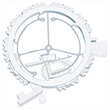2008

The white paper prepared for the Department of Energy, Office of Science, Office of Basic Energy Sciences by the management and users of the Advanced Photon Source to set the foundation for renewal of this vital national research facility is now available in PDF format.

Diane Riendeau, winner of the 2008 American Association for the Advancement of Science (AAAS) Leadership in Science Education Prize for High School Teachers, paid a visit to Argonne National Laboratory on October 1, 2008.

As Guvenc Akgul goes about learning the finer points of x-ray spectroscopy from his colleagues at the U.S. Department of Energy’s (DOE’s) Advanced Photon Source (APS) at Argonne National Laboratory, he represents a bridge between countries that, while separated by culture, distance, or regional factionalism, can find common ground in science at synchrotron x-ray research facilities.

From the time of Roentgen’s first experiments with x-rays in 1895, these miraculous gifts of invisible light have afforded us an opportunity to visualize the unseen.

Thanks to very effective advocacy by Advanced Photon Source (APS) users, and the support of the U.S. Congress, the APS has received an injection of funds that will enable the facility to function normally, at least until it receives a 2009 federal budget, expected next spring.

Argonne expertise will once again be in the spotlight when the Linac Coherent Light Source (LCLS), the U.S. Department of Energy’s next-generation, x-ray free-electron laser light source, enables frontier materials and biological research at the Stanford Linear Accelerator Center (SLAC) beginning in 2009.

What could have been a shattering let-down for NASA’s Genesis Discovery Mission has become an opportunity for synchrotron light source science to shine. NASA’s Genesis Discovery Mission was a space probe that went out beyond Earth’s atmosphere to capture solar wind from our Sun.

Outstanding Service Awards (OSAs), the highest honor the university gives to Argonne employees in support positions, will be awarded to Joseph L. Midlock, computer scientist, APS Engineering Support Division; and Susan Barr Strasser, manager, User Programs, X-Ray Science Division.

Tim Fister, who is currently a postdoc in the Argonne Materials Science Division working with Paul Fuoss, has been awarded the Henderson Prize by the University of Washington (UW) Physics Department for the outstanding Ph.D. thesis from his graduating year.

The final five (of 40) extruded aluminum vacuum chambers for the Linac Coherent Light Source (LCLS) undulator system have been shipped from Argonne National Laboratory

The first undulator support girder assembly for the Linac Coherent Light Source (LCLS) at the Stanford Linear Accelerator Center (SLAC) made its way from the Collider Hall, where technicians are piecing them together, to the Magnetic Measurement Facility for final alignment.

The Advanced Photon Source (APS) Users Organization has named Oleg G. Shpyrko of the University of California, San Diego, as the recipient of the 2008 Rosalind Franklin Young Investigator Award.

The earthquake that occurred in Illinois’ Wabash Valley fault system on Friday, April 18, could have caused a fault of different kind — a system fault that could have interrupted delivery of high-brightness x-ray beams to researchers using the Argonne Advanced Photon Source (APS).

The 2008 Three-Way Meeting (3WM) between the European Synchrotron Radiation Facility (ESRF), the Super Photon Ring-8 GeV (SPring-8), and the Advanced Photon Source (APS) was held at Argonne on March 18-19, 2008, with more than 20 representatives from each facility.

The diamond anvil cell (DAC) is the most commonly used device for obtaining static high pressures above 3 GPa. Experiments in the DAC are frequently performed at the APS, in particular at GSECARS (Sector 13), HP-CAT (Sector 16), and at XOR sectors 1 and 3.

“The Advanced Photon Source (APS) at the U.S. Dept. of Energy's Argonne National Laboratory has been kept busy of late.”

Ken Sidorowicz, Information Technology (IT) Group Leader in the APS Engineering Support Division (AES), was named the Scientific User Facilities (SUF) 2007 Supervisor of the Year “based upon his demonstrated outstanding technical leadership, which is exemplified by his leadership, his ability to inspire and motivate his team, and his proactive approach to promoting the success of the APS … through application of new trends in information technology.”

Practitioners of the environmental sciences have traditionally been under-represented as users of x-ray spectromicroscopy tools.

The intricate dance of electrons at the interface between ferromagnetic and superconducting oxides that was studied with unprecedented clarity by researchers using an Advanced Photon Source (APS) beamline, has been selected as one of the breakthroughs of the year for 2007 by Science magazine.

Cutting-edge science that could help shape our energy future, combined with the graphic arts, has resulted in an award-winning scientific illustration based on experimentation carried out at the Argonne Advanced Photon Source (APS).
